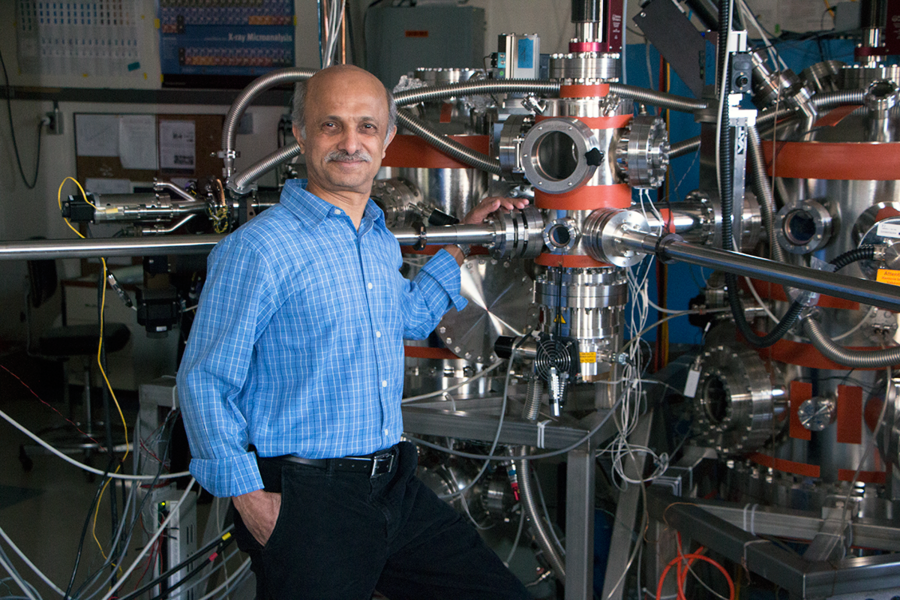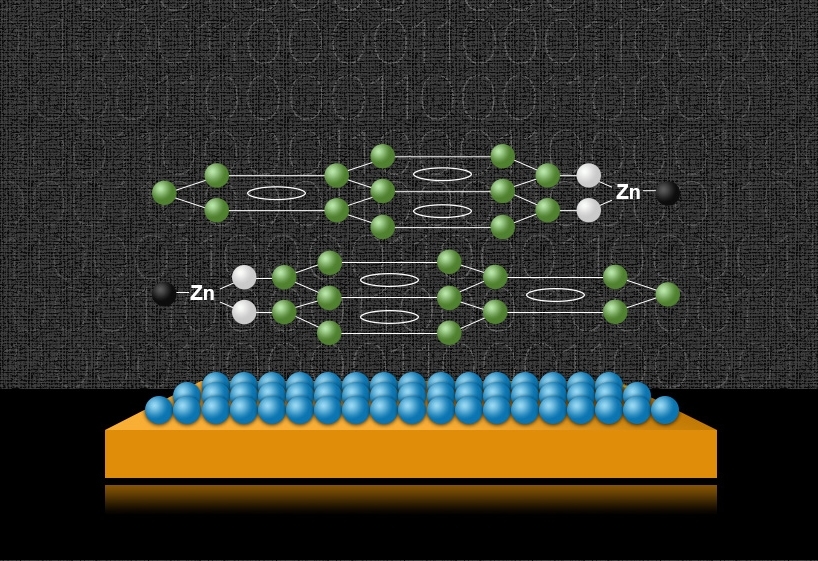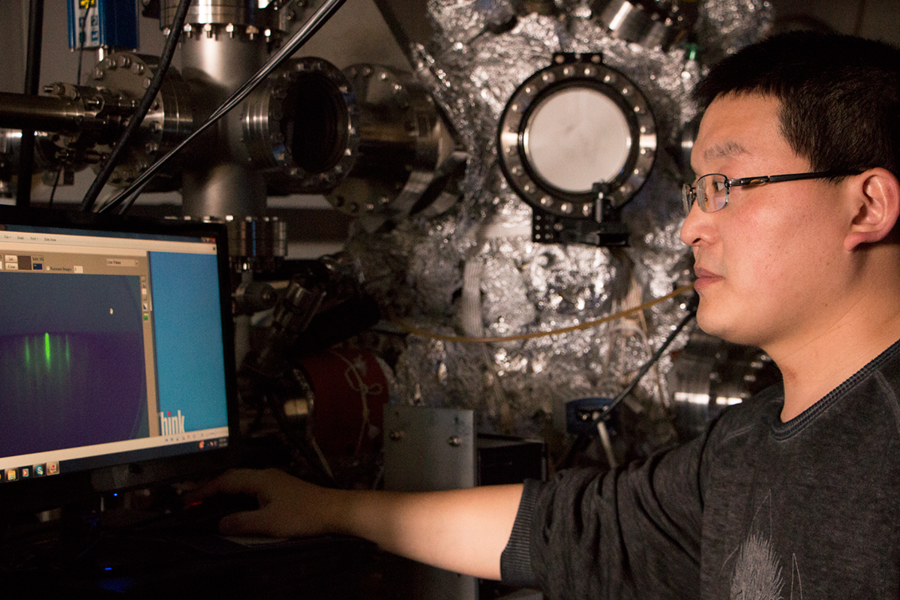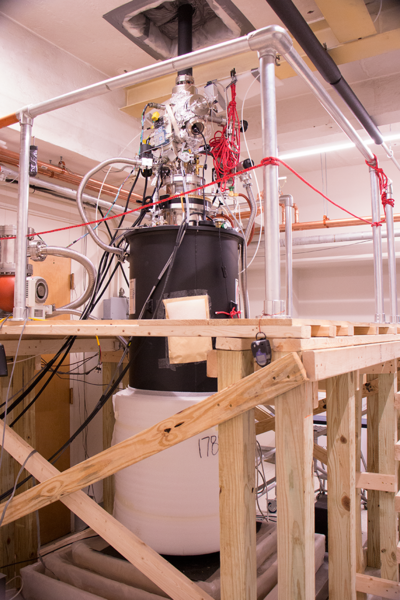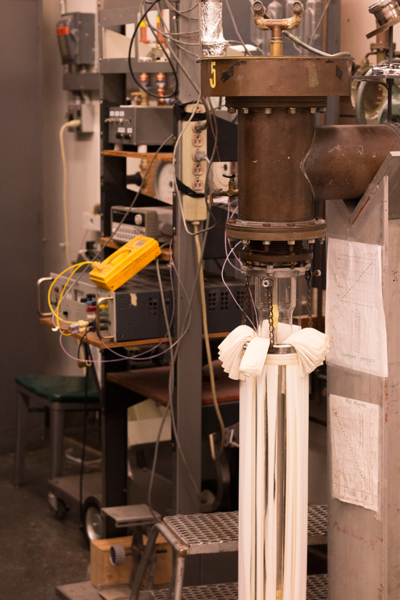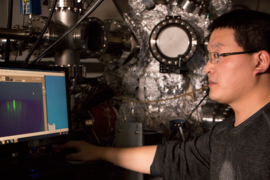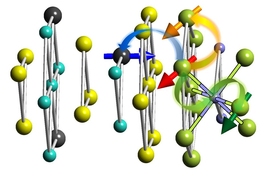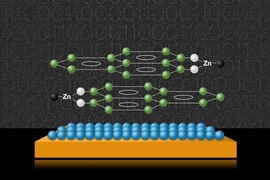MIT Physics Department Senior Research Scientist Jagadeesh S. Moodera was one of the pioneers in the field of spin-polarized magnetic tunnel junctions, which led to a thousand-fold increase in hard disk storage capacity. Using his group’s expertise working with atomically thin materials that exhibit exotic features, Moodera is laying a step-by-step foundation toward a new generation of quantum computers.
Moodera’s group is making progress toward devices that display resistance-free, spin-polarized electrical current; memory storage at the level of single molecules; and capture the elusive paired electron “halves” known as Majorana fermions, which are sought after as qubits for quantum computing.
This work combines materials that allow the free flow of electrons only on their surface (topological insulators) with other materials that lose their resistance to electricity (superconductors). Researchers call mixed layers of these materials heterostructures. A key goal is to push these effects up from ultracold temperatures to ordinary temperatures for everyday use.
“Our group specializes in the growth and understanding the physical phenomena at the atomic level of any number of exotic combinations of these materials plus heterostructures with different other materials such as ferromagnetic layers or superconductors and so on,” Moodera says.
Hunting Majorana fermions
Majorana fermions, which can be thought of as a paired “electron halves,” may lead to creating quantum entanglement believed necessary for quantum computers. “Our first goal is to look for the Majorana fermions, unambiguously detect them, and show this is it. It’s been the goal for many people for a long time. It’s one of those things predicted 80 years ago, and yet to be shown in a conclusive manner,” Moodera says.
Moodera’s group is searching for these Majorana fermions on the surface of gold, a phenomenon predicted in 2012 by William and Emma Rogers Professor of Physics Patrick Lee and Andrew C. Potter PhD ’13. “I have a lot of hope that it’s going to come up with something very interesting, this particular area is exotically rich,” Moodera says.
His team reported progress toward this goal in a Nano Letters paper published on March 4. Postdoc Peng Wei, with fellow Moodera group postdocs Ferhat Katmis and Cui-Zu Chang, demonstrate that epitaxial (111)-oriented gold thin films become superconducting when grown on top of superconducting vanadium film. The vanadium becomes a superconductor below 4 kelvins, which is hundreds of degrees below room temperature. Tests show that the surface state of (111)-oriented gold also becomes superconducting, which holds out potential for this system in the search for Majorana fermions.
Future work will seek to detect Majorana fermions on the ends of (111)-oriented gold nanowires. “In this kind of nanowire, in principle, we would expect Majorana fermion states to exist at the end of the nanowire instead of in the middle,” Wei explains. Moodera says, “We have not discovered Majorana fermions yet, however, we have made a very nice foundation for that.” Further results will be published soon.
Free flowing current
In a series of 2015 papers, Moodera’s group demonstrated the first reported truly zero-resistance edge current in the quantum anomalous Hall state of a topological insulator system, realizing a 1988 prediction by F. Duncan M. Haldane at Princeton University. The importance of comprehensive achievements of perfect quantum anomalous Hall state at zero magnetic field as well as the demonstration of dissipationless chiral edge current in a topological insulator is well brought out in a Journal Club for Condensed Matter Physics commentary by Harvard University Professor Bertrand I. Halperin, a pioneer in the field. “In this system, there is a very special edge state. The bulk is insulating, but the edge is metallic,” says Cui-Zu Chang, lead author of the Nature Materials paper and Physical Review Letters paper published in April and July 2015.
“Our group is the first to show a completely dissipationless edge state, meaning that the resistance for current flow exactly becomes zero when the quantum state is reached at low temperatures,” Chang says. “If one can realize this effect, for example, at room temperature, it will be remarkably valuable. You can use this kind of effect to develop quantum electronics including the quantum computer,” Chang says. “In this kind of computer, there is minimal heating effect; the current flow is completely dissipationless; and you can also communicate over very long distance.”
New spintronics
In a 2013 paper with collaborators from Northeastern University, Göttingen University in Germany and Spence High School in New York, Moodera and MIT postdoc Bin Li demonstrated a superconducting spin switch in a structure sandwiching an aluminum layer between europium sulfide layers. In this work, the intrinsic magnetization of europium sulfide controls superconductivity in the aluminum layer. The direction of magnetization in europium sulfide can be reversed, which can thereby switch the aluminum between superconducting and normal states, making it potentially useful for logic circuits and nonvolatile memory applications a step in the direction of superconducting spintronics. These experiments validated a theoretical prediction 50 years ago by French Nobel Laureate Pierre-Gilles deGennes.
Several years ago Guoxing Miao, then a junior researcher with Moodera, observed a unique energy profile across a sandwich structure made with metallic islands confined within two europium sulfide magnetic insulator barriers. This arrangement of the inherent large energy separation in the nano islands combined with the large interfacial magnetic field confined at the interface and the spin selective transmission property of the adjacent europium sulfide powerfully modifies the two-dimensional electronic structures. They observed spin-assisted charge transfer across such a device, generating a spontaneous spin current and voltage. These unique properties can be practical for controlling spin flows in electronic devices and for energy harvesting. Published in Nature Communications in April 2014, these were unexpected fundamental results, Moodera says. Guoxing Miao is an assistant professor at University of Waterloo and Institute for Quantum Computing in Canada.
More recently, the researchers paired europium sulfide with graphene, creating a strong edge current, which they reported March 28 in Nature Materials. “What we find is very exciting,” postdoc Peng Wei, lead author of the paper, says: “Experiments show a strong magnetic field (more than 14 Tesla) experienced by graphene originating in the europium sulfide that polarizes the spins of electrons in the graphene layer without affecting the orbital motion of the electrons.”
In the device, europium sulfide produces a large field, called a magnetic exchange field, which raises the energy of spin-up electrons and lowers the energy of spin-down electrons in graphene and creates an edge current with spin-up electrons streaming in one direction and spin-down electrons streaming in the opposite direction. These effects are brought about by the confinement of electrons in these atomically thin devices, fellow postdoc Ferhat Katmis explains. At the interface between europium sulfide, which is a magnetic insulator, and graphene, Peng Wei explains, the graphene can “feel” the huge exchange field, or internal magnetism, which can reach millions times bigger than the Earth’s magnetic field, from the europium sulfide. This effect is potentially useful for spin-based memory and logic devices and possibly quantum computing.
Big organic molecules
Moodera was a guest editor of the July 2014 MRS Bulletin, which highlighted progress in organic spintronics. Controlling magnetic behavior at the interface of the materials is again the key element in this approach. By adding magnetic sensing capability to these large organic molecules (up to hundreds of atoms per molecule), their magnetic orientation can be switched back and forth. This work holds promise to serve as photo-switches, color displays, and information storage units at the molecular level.
These molecules can start out completely non-magnetic, but when they are placed on the surface of a magnetic material, their behavior changes. “They share electrons at the interface. These molecules share some of their electrons into the ferromagnetic layer or the ferromagnetic layer actually gives out some of its electrons carrying with it the magnetic behavior,” Moodera explains. Electrons from the magnetic material carry a magnetic signature, which influences the organic molecule to switch between resistive and conductive states. This collaborative work between researchers in the U.S., Germany, and India was published as a Nature Letter paper in 2013.
Moodera and co-inventor Karthik V. Raman PhD ’11 were issued a patent in May 2014 for high-density molecular memory storage. It is one of four patents issued to Moodera and colleagues.
“We have shown early stages of such a possibility of these molecules being used for storing information,” Moodera says. “This is what we want to explore. This will allow us to store information in molecules in the future.” He projects that molecular storage can increase storage density by 1,000 to 10,000 times compared to current technology. “That gives you an idea of how powerful it can become,” he says. Organic molecules have other advantages as well, he says, including lower cost, less energy consumption, flexibility and more environmentally friendly materials.
“But it’s a very, very huge area, almost untapped direction where many unprecedented new phenomena might emerge if it can be patiently investigated fundamentally,” he cautions. Moodera is currently seeking long-term funding for this research into permanent memory devices using magnetic single molecules. “It’s a visionary program which means somebody has to be patient,” Moodera explains. “We are quite capable of doing this here if we get good support. ... Everything has to be looked at and understood, and then go further, so there is no set a priori recipe for this!”
Historic breakthrough
In 2009, Moodera and two MIT colleagues (the late Robert Meservey and Paul Tedrow, then group leader) shared the Oliver E. Buckley Condensed Matter Prize from the American Physical Society with Terunobu Miyazaki from Tohuku University in Japan for "pioneering work in the field of spin-dependent tunneling and for the application of these phenomena to the field of magnetoelectronics (also called spintronics)."
“Jagadeesh Moodera and team were the first to show magnetoresistance from a magnetic tunnel junction at room temperature — a fundamental discovery that has enabled rapid growth of data storage capacity. All hard disk drives made since 2005 have a MTJ as the read sensor,” says Tiffany Santos ’02, PhD ’07, a former Moodera lab member who now works as a principal research engineer at HGST in San Francisco. As a materials science undergraduate and then doctoral student in Moodera's group, Santos explored spin-polarized tunneling in MTJs made of novel materials such as magnetic semiconductors and organic molecules. Santos was awarded best thesis prize from the Department of Materials Science and Engineering both for her BS and PhD theses.
In common bar magnets, which have north and south poles, two magnets are attracted if opposite poles face, but will repel if the same poles face each other. Similarly, in a magnetic tunnel junction, the current flow across the layered materials will behave differently depending on whether the magnetism of the layers points in the same, or in the opposite, direction — either resisting the flow of current or enhancing it. This spin tunneling work, which dates to the 1990s, revealed that pairing two thin magnetic materials separated by a thin insulator causes electrons to move, or “quantum tunnel,” through the insulator from one magnet to the other, which is why it is called a magnetic tunnel junction. “This change in the current flow, very significant, can be detected very easily,” Moodera says.
Since these magnetic materials are atomically thin, rather than north and south poles, their magnetism is associated with the up or down spin of electrons, which is a quantum property, and they are characterized as parallel when their spins are in alignment, or antiparallel when their spins point in the opposite directions. “So all you have to do is change from parallel to anti-parallel orientation, and there you have this beautiful spin sensor, or spin memory,” Moodera says. “This spin memory is non-volatile; that’s the most striking thing about it. You can set this particular device in a particular orientation, leave it alone, after a million years it’ll be still like that; meaning that the information which is stored here will be permanent.”
Institute Professor Mildred S. Dresselhaus has known Moodera for many years, initially through his work using magnetic fields for materials research. Moodera, she says, developed expertise in spin phenomena long before they became popular topics in science and he has attained similar status in topological insulators. “His career has been all like that. He works for the love of science, and he’s not particularly interested in recognition,” Dresselhaus adds. Although Moodera has never been a faculty member, he works effectively with students and he finds his own support, she notes. “MIT is a place that can accommodate people like him,” Dresselhaus says.
Funding constraints
Limited funding means the U.S. is in danger of losing its leadership role in research, Moodera fears. He involves high school students and undergraduates (nearly 150 so far) in his research, many becoming coauthors in the publications and patents. “When we tell the young students and postdocs, ‘Oh, physics is wonderful, you should get into research, you really can discover many things that are exciting and valuable’, we are not actually telling the whole story. Despite funding support from National Science Foundation and Office of Naval Research for our program, there is increasing uncertainty and pressure to raise research funds. ... With constant struggle for funds, one spends much time in dealing with these issues. ... We wish there is reliable and continuous support when the track record is good. Science is like art — if creative breakthroughs are needed, then the proper support should be there with long-term vision, with freedom to explore, and without breaks and uncertainties. When one looks at some of the breakthroughs we have achieved so far — magnetic tunnel junctions that drives all hard drives in computers, prototype molecular spin memory, nonvolatile perfect superconducting spin memory/switch or even the latest totally spin-polarized edge current which is perfectly dissipationless, evidently the foundations for tomorrow’s cutting edge technology, isn’t it crystal clear that such a research program be unequivocally supported to benefit our society?” he asks.
Despite his lab’s prominence in spintronics and topological insulators, making further progress in the current research environment means he depends on federal and other outside grants. “If I don’t have funding, I close the shop,” he says. “Everything moves so fast, you cannot wait for tomorrow. Everything has to happen today, that’s the unfortunate thing dealing with uncertainty. It’s a lot of pressure and stress on us, particularly in the last 10 years. The funding situation has become so volatile that we are kept under the dark cloud, constantly concerned about what is coming next.”
Yet the situation has not always been so. During a tour of his lab facilities, Moodera recalls a phone call (over 20 years ago) from an Office of Naval Research (ONR) program director, Krystl Hathaway, who suggested there was money available, his work was high-quality, and that he should apply. “That was when I had only a month or two of funds left to sustain a research program! So, I said yes! I couldn’t believe it in the beginning,” he recalls. “I put in a one-page application. In a week’s time she sent me the money to tidy me out for four months. After that, I put in a real, several-page proposal for a full grant, and she supported my research program for over 10 years. Two years after this support started, research led to the discovery of the phenomenon called the tunnel magnetoresistance in 1994-95, which besides creating a vast new area of research, is also instrumental in the explosion of unbelievable storage capacity and speed in computer hard drives as we enjoy today at rock bottom cost. Most notable is that this work was mainly done with a summer high school intern who later joined MIT [Lisa Kinder, '99] and an undergraduate [Terrilyn Wong '97].”
Later, when the same program officer was at a Materials Research Society (MRS) meeting in Boston, she visited Moodera’s lab and noticed the age of a key piece of thin film equipment used in creating the tunnel magnetoresistance breakthrough. It was then about 35 years old and had been cobbled together mostly from salvaged parts. Again she volunteered to provide substantial funding to build specialized equipment for a technique called molecular beam epitaxy (MBE), which is used to create ultra-clean thin films, atomic layer by atomic layer. On vacation in India, Moodera got a phone call from a physics administrator (the late Margaret O'Meara), telling him Hathaway from ONR was urgently looking for him. “I came back the next day, and then I spent four hours writing a proposal, which another two hours later was submitted from MIT. It all happened in one day essentially, and one week later I got $350,000, which built our first MBE system,” he says. “It’s a very versatile system that even after 20 years continues to deliver big results in the growth and investigation of the field of quantum coherent materials at present. By carefully planning and optimizing we even got some other critical parts that we needed for our other equipment in the lab.”
“Dr. Hathaway, and then subsequently Dr. Chagaan Baatar, the new program director at ONR, were very happy that we produced a lot more things in the new system. It made a huge difference in our program. So that’s how sometimes it works out, and fundamental research should be supported if one looks for breakthroughs!” he says. “People come in and see, 'these people need support'. So that kind of thing should happen now, I think.”
Funding for basic science has to increase by manyfold, Moodera suggests. “The future is actually created and defined now. Evidently it’s very important then. If you don’t invest now, there is no future development. A vision for fundamental knowledge buildup is strongly eroding in the country now, and thus needs to be corrected before it reaches the point of no return,” he says.
Training real scientists
Moodera has been at MIT for over three decades, where his group is part of the Francis Bitter Magnet Laboratory (which is now under Plasma Science and Fusion Center) and the Department of Physics. Moodera’s lab equipment ranges from the newest two-story scanning tunneling microscope that can examine atomic surfaces and molecules under extreme cold and high magnetic fields to a 1960s’ vintage glass liquid helium cryostat, which still sees frequent use. “It’s not the equipment. It’s how you think about a problem and solve it, that’s our way of looking at things. ... We train real scientists here; ones that can really think, come up with something out of essentially nothing. To start from basic atoms and molecules and actually build things, completely new and understand the emerging phenomena; unexpected science can come out of it,” Moodera says.
“This group has solved important physics in ferromagnetism,” postdoc Peng Wei says. “We actually have very unique equipment that cannot be seen in other labs.”
A native of Bangalore, India, Moodera plays badminton, ping-pong, and tennis, and he follows world tennis, soccer, and cricket. With his wife, MIT Department of Materials Science and Engineering senior lecturer Geetha Berera, Moodera likes to hike and enjoy nature. His hobbies include gardening and bird watching.
